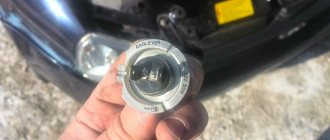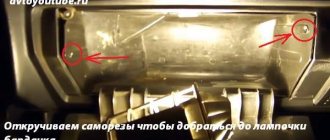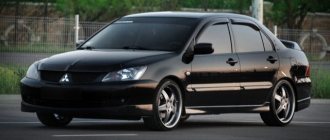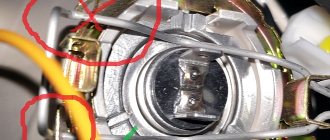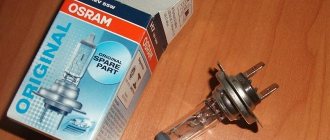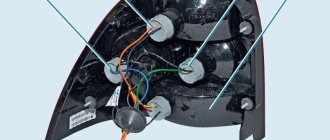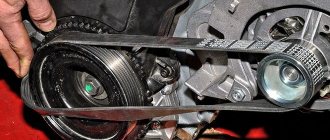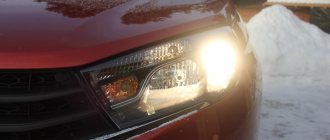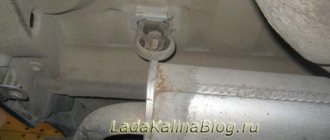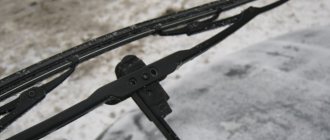On modern Lada cars (Vesta, Granta or Kalina 2), a double-filament lamp (W21/5W) is used as dimensions and daytime running lights (DRL). A small tuning of the optics is to get rid of the yellowness of the standard incandescent lamps. To do this, LEDs are installed instead of them, having previously been modified in a certain way.
Before replacing, you should find out what the polarity or pinout is in the DRL socket. On modern Lada models the polarity is non-standard:
- there should be a “ground” on one side of the lamp (can be one common contact or two);
- on the other - “plus” for dimensions and “plus” for DRLs.
When buying LEDs, make sure that the polarity on the base matches the polarity in the socket (look for LEDs W21/5W, P27/7W (3157, 7443) with the abbreviation SRCK or SK type). Many car enthusiasts, not finding these, bend the antennae in the required order (connecting the “ground” on one side, and bringing the two “pluses” to the other). Before installing LEDs in headlights, check their operation using a battery.
Attention! Such tuning can damage a fuse, an additional body electronics unit or wiring. In this case, the vehicle warranty is not valid.
The process of replacing lamps with LEDs is also shown in the video:
Let us remind you that the process of replacing DRL lamps and dimensions is available in detail separately for Lada Vesta and Lada Granta and Kalina 2. Look for other improvements in the “Tuning” menu.
The Kalina and Kalina 2 models have different headlights, so replacing the lamps in them has certain differences, and we will describe which ones in this article. Replacing the lamps yourself will not cause you any problems. Therefore, there is no point in turning to the service for help.
On Kalina 2 from 2013, to replace the lamps in the left headlight unit, you need to move the air filter to the side so that it does not interfere. There will be nothing in the right headlight block that will prevent replacement.
Carrying out replacement work yourself
Before replacing the lamp, a number of preparatory operations are required. In particular, during the work you will need:
- the lamps themselves (one or two);
- hand tools (set of wrenches, pliers, screwdrivers);
- thin, clean work gloves;
- a bottle of alcohol or vodka and a piece of clean cloth.
The car itself should also be prepared before changing the lamp.
It needs to be installed on a level area with the handbrake on, and chocks placed under the wheels to prevent possible rolling of the car.
The car, of course, must be turned off.
When all operations have been completed, you can open the hood and disconnect the power from the negative terminal of the battery. This is done to prevent a short circuit from occurring. When low beam, in this case it will be necessary to dismantle the headlight washer reservoir.
The lamp can be changed with or without removing the headlight from the car. When you decide not to remove the entire block, you first need to pull any petal of the rubber plug that secures the lamp in the headlight. The order in which the wires fit to the lamp must be remembered or sketched. Next, you need to carefully remove the spring clamp of the lamp itself by pressing on it and disengaging it. This must be done carefully, otherwise it may fall into the lighting fixture itself, which will entail dismantling the entire headlight unit. The lamp that requires replacement must be removed and a new one put in its place.
Installation of a new lamp must be carried out with gloves, otherwise the grease marks that will remain on the lighting device will reduce its service life. When contact does occur, the lamp must be wiped with a cloth soaked in an alcohol solution. The remaining operations to replace the lamp are carried out in the reverse order of disassembly.
When the assembly is completed, you can start the car and check the functionality of the low beam.
Recently I encountered a problem. When I turned on the low beam at night, I was surprised to find that it was simply not there. Before that, I traveled to Russia, where it is mandatory to turn on the lights during the daytime. Therefore, when the low beam disappeared and what caused it, I did not know.
The electrical circuit for turning on the low beam in Kalina is extremely simple. Along the path of electric current from the power source (battery or generator) to the low beam bulb there are fuses, a lighting unit, and a low/high beam switch.
The search began with the simplest thing - checking the fuses. They turned out to be fine. After two more causes have been ruled out (the lighting unit and the headlight switch), it is time to check the low beam lamps.
What can I say, this is a very, very inconvenient matter, especially if you are doing it for the first time and do not know all the design subtleties.
IMPORTANT! Everything stated below is my personal experience. It is not a fact that the technology described is correct. Therefore, the author does not bear any responsibility for any possible damage caused as a result of the actions described below.
I started with the right headlight. In order to get to the lamp, I had to remove the windshield washer fluid reservoir. It turned out to be quite simple. In order to remove the windshield washer reservoir you need to:
- Remove the terminals from the motor contacts (two motors, in the case of a station wagon or hatchback), first remembering how they are connected;
- Unscrew the front bolt securing the tank, which is located above the headlight;
- Loosen the nut that clamps the rear reservoir mount near the shock absorber strut;
- Carefully remove the tank without spilling its contents.
After this we get completely normal access to the headlight.
Procedure for removing the low beam headlight:
- Remove the rubber cover to access the headlight;
- Carefully remove the two headlight power wires, remembering their location;
- Gently press and slightly lift the iron latch;
- After the bracket is removed from the grooves, move it to the side;
- Carefully remove the low beam lamp by the contacts.
The procedure for installing the low beam lamp is reversed. IMPORTANT! Under no circumstances should you touch the glass part of the lamp with your hands, because... When turned on, it will immediately burn out. If this happens, you should thoroughly wipe the glass part of the lamp with alcohol and let it evaporate completely.
Procedure for installing low beam headlights:
- Install the low beam lamp so that its protrusion on the base fits into the corresponding groove on the lampshade, thereby securely fixing it.
- After this, the most difficult part of replacing the lamp is performed - you need to carefully fix the lamp with a latch, falling exactly into the grooves, and you need to make sure that the lamp itself does not rotate in the lampshade. To do this, the latch is wound up a little from the top, then pressed lightly and lowered down.
- If everything went well, you should definitely check the reliability of the lamp so that it is securely held by the latch and does not rotate around its axis.
- Connect the wires, observing polarity;
- Close the hole to access the lamp with a rubber cover;
- Reinstall the windshield washer reservoir, securing it and connecting the wires.
After this, if necessary, you can proceed to replacing the left low beam lamp. Access to this lamp is much worse, because... It is almost impossible to remove the coolant reservoir without draining the antifreeze. Therefore, you have to dodge and act by touch.
Several years ago, the government approved a law according to which during the daytime it is necessary to drive a car with either low beam headlights or DRLs (daytime running lights). As a result, car low beam lamps began to burn out much more often. The first generation Lada Kalina is no exception. Those who do not want to drive with low beam headlights install daytime running lights. Kalina 1, unlike the second generation model, does not have DRLs, so you have to drive with low beam headlights. From our instructions you will learn how to replace the lamps in the front headlight unit, as well as the reasons why these lamps may not work.
Before you start repairs
Before changing the low beam lamp on Kalina, you need to check the integrity of the on-board network:
- When understanding the causes of failure of any component of electrical equipment, you should first make sure:
- the fuse is in good working order;
- look at the circuit connectors, which should be well secured;
- Often the causes of electrical equipment malfunctions are the oxidized ends of the pads; their terminals should be cleaned.
- Take a good look at the places where the car is connected to ground. Often, due to the lack of reliable fastening, disturbances in the functioning of electrical equipment occur, so replacing low beam lamps on Kalina may not always help with the problem.
- the equipment will help to find faulty places in the electrical circuit;
- is a combined electrical measuring device.
There are several types of such devices:
- digital, equipped with a liquid crystal display;
- analog;
- universal models, characterized by the presence of a liquid crystal screen and a dial indicator.
Multimeter
During repairs, we recommend using a digital device (in other words, a multimeter), which is small in size.
To check de-energized circuits, the device should be switched to ohmmeter mode:
- if you need to measure very low resistance (for example, within a few Ohms), you should enter a clarification - from the obtained indicator we subtract the internal resistance, the electrical resistance of the probes and multimeter wires (within 0.07 Ohms);
- to determine a more accurate value, the device is switched to the mode for measuring low resistance values (up to two hundred Ohms), then the ends of the probes should be short-circuited.
To check live circuits, the multimeter should be switched to voltmeter mode (the limits of permissible measurements are up to twenty volts). The device is capable of measuring the current consumed by electrical equipment of vehicles (up to ten amperes).
In cases where the task is to find out whether or not there is voltage in a certain section of the circuit, without resorting to measuring the value, you can use a special indicator light designed for twelve volts. You can also use a test lamp.
You can make it yourself:
- you will need a car lamp with a power of up to 4 W;
- take 2 two wires, the length of which is from 500 mm;
- solder them to the lamp.
The car is equipped with 2 headlights, in which halogen lamps are mounted. There are two screws on each to adjust the light beam. They make it possible to change its direction in the vertical and horizontal planes.
Adjusting the headlight beam
Correctly adjusting headlights can only be done in a service station. However, let's look at how this operation is performed by experienced craftsmen.
Kalina-2 block headlight, correct adjustment of the beam direction
There are two adjustment screws on the back wall of the unit called the headlight unit. The first of them, located closer to the radiator, allows you to deflect the light beam “up and down”, and the “horizontal” direction is adjusted with the second screw. Ideally, this should happen: when the car is 5 meters from the screen, the border of the light spot touches line “2” (see figure). Line “1” is spaced from the ground at a distance equal to the height of the centers of the headlights. The second line is drawn 65 mm lower.
When making adjustments, the corrector switch is moved to position “0”. Of course, you only need to turn on the low beam. We also note that the headlights are adjusted one by one (the “excess” light source is covered with a cloth).
Here are a couple more tips that will be useful:
- The centers of the beams should be on lines AE, BE;
- Line “0” has the following meaning: it intersects with line “1” at one point, so the border of the spot should pass exactly through this point;
- The caps of the plastic adjustment screws are compatible with a hex screwdriver. However, a Phillips screwdriver will also work.
Instructions for replacing lamps on Kalina 2
Low beam
Carefully remove the rubber boot from the low beam (it is larger in size)
Disconnect the block from the lamp
Next, press the spring clamp and remove it from the clamps to the side and move it away
We remove the burnt out one and install a new lamp. The H7 Osram lamp is installed from the factory; if you want to install brighter lamps, you can choose the Philips H7 +30.
We reassemble in reverse order.
High beam
Remove the rubber boot from the high beam
Disconnect the block from the lamp (Only the + wire is attached to the lamp)
Press the spring clamp of the lamp and move it to the side
We take out the old lamp and install a new one. Be careful when installing, it can only be installed in one position.
We also perform assembly in reverse order.
Replacing DRL lamps
Take the cartridge and turn it counterclockwise.
Next, remove the socket from the socket, take out the old lamp and install a new one. Toshiba lamps are installed from the factory; it is impossible to buy them in retail stores, so we choose an analogue.
2302-18-10-10 (Copy)
We install the new W21/5W lamp in the reverse order.
Replacing headlight bulbs on a car manufactured before 2013
The only difference in the procedure for replacing lamps in the headlight of a car manufactured before 2013 is that the side light lamp is located under the high beam lamp cover, and the daytime running light lamp is simply absent.
We will show you the replacement of the side light lamp on the right headlight unit.
Kalina's low beam lamp has a direct connection with road safety. The light element illuminates the side of the road, the road surface, and also prevents oncoming traffic from being dazzled. The lamp is designed for 2-4 years of service depending on the manufacturer. When replacing, even an inexperienced user will not need to dismantle the headlight and use complex tools.
Replacing low beam lamps with your own hands
Changing them in headlights is one of the simplest procedures, which is quite accessible to a beginner. The only thing that needs to be taken into account are some nuances. They depend on the modification of the car.
Instructions for replacing low beam in Kalina 1
Changing such a part is very simple. First you need to open the hood and turn off the power to the on-board network by disconnecting the terminals from the battery. To make it easier to change, it is recommended to dismantle and move the reservoir with windshield washer fluid to the right. Next, you need to remove the protective cover of the headlight and pull out the desired lamp. To remove it, just slightly squeeze the latch and then remove the terminal.
When installing a new lamp, do not touch it with your fingers. Otherwise, greasy marks will cause a decrease in resource. If this happens, you can wipe the glass flask with alcohol.
Replacement in Kalina 2
Everything is simple here too. It is enough to remove the rubber boot and disconnect the terminal from the lamp contacts, then press the latch and remove the lamp. Installation is carried out in reverse order.
How to replace the lamps yourself
Changing a light bulb in Kalina yourself is not difficult. The time spent on the work depends on the skill of the driver and the size of the hands. Some owners change light fixtures in 15-20 minutes without removing the headlight, while others suffer for more than an hour and ultimately dismantle the optics.
When replacing, cloth gloves are used. This helps protect the skin on your hands and also prevents contact with the bulb. When touched, fingerprints remain, which heat up when the light is turned on and after a while burn through the thin glass.
During work, the battery terminal is unscrewed to avoid a short circuit, which will lead to burnout of the fuse link in the fuse box.
Far module
Replacing the high beam lamp is easier than in the low beam module, since the cover is located closer to the radiator grille.
To perform the operation you will need:
- Turn off the Kalina engine.
- Open the hood lid.
- Remove the protective boot on the back of the flashlight.
- Carefully disconnect the plastic chip.
- Open the latch.
- Pull out the lamp.
Assembly is carried out in reverse order. When installing the terminal, you need to check the contacts and, if necessary, clean them using a flat-head screwdriver, sandpaper or a special chemical spray.
Low beam
Replacing a low beam lamp on a Lada Kalina depends on the experience of the owner and is divided into two types:
- Without removing the headlight.
- With module dismantling.
Most Kalina owners cannot replace the lamp in the left headlight due to limited space. In this case, you will have to ask a more dexterous friend or dismantle the lighting device yourself for convenience.
To change lamps on installed optics:
- Unscrew the filter housing near the left headlight and move it towards the engine.
- Disconnect the washer motor terminal, remove the screws and move the reservoir to the side.
- Open the light module seals.
- Remove the block with wires.
- Remove the spring clip.
- Remove the part.
How the work is carried out
Let's figure out how to replace the low beam light bulb on Kalina with your own hands, the process is quite simple and, by and large, does not require any special devices, you only need your hands. But still, the tool may be needed at the preparation stage.
Preparation
It is important to ensure a comfortable and safe working environment, so remember the following:
- The work can be done anywhere - even in the yard near the house, but it is advisable to go to the garage. There you can not be afraid of precipitation and, if necessary, find this or that tool.
- First of all, the hood is opened and the terminal is removed from the battery. We remind you of this in every review. Therefore, make it a habit to de-energize the system when working with electrical equipment to prevent short circuits and electric shock.
- Further preparation depends on what engine is installed in your car, you need to provide access to the rear of the headlight housing, and for this you need to disconnect the expansion tank on the left, and the options on the right may be different. Therefore, be guided by the situation and decide for yourself. What needs to be removed and what should not be touched.
Design Features
Kalina's light is not technologically advanced, since the optics use classic halogen elements. From the factory, the modules contain parts from Philips or Osram with the Long Life prefix, which means an increased service life.
The Kalina lighting system in the old and new body differs in the location of the modules, shape, and size. The elements used in optics are:
- turn signals – PY21W;
- low beam – H7/55 W;
- high beam – H1/60 W;
- fog lights – H11/55 W;
- Dimensions – W5W.
In modifications of Kalina since 2013, running lights have been added from the factory, which use parts with the index W21/5W.
Some car owners cannot fit their hand into the cramped space between the TV and the air filter housing. In this case, the Kalina intake system is dismantled or the radiator grille and headlight are removed.
Tail lights and lamps
The following elements are used as brake light lamps in Kalina-2: lamps with a P21W socket and a transparent bulb. Replacing such an element will not be difficult.
Brake light bulb, VAZ-2192/2194
The rear turn signals are equipped with the same bulbs as discussed above. Their bulb is colored yellow (type PY21W).
The reversing light in the hatchback is provided by a lamp of the following standard size - R10W. If we talk about the station wagon, they use lamps of a different type - W16W. They do not have a metal base.
These are the reversing lamps
In conclusion, we note the following: the light of the side and fog lights in the rear lights is provided by a combination lamp. Its standard size is P21/4W. Good luck with your choice!
It is important to know! When performing any actions with electrical equipment, you must first disconnect the negative terminal of the battery. The terminal fastening is unscrewed with a 10 mm wrench.
Which lamps are best to use in Kalina
To find out which lamps are installed in Kalina during assembly, you need to remove the cover and pull out the part. The name, model and type of spare part are printed on the case. AvtoVAZ uses products from Philips as the main light. However, some models contain parts from Osram.
When searching for light bulbs in Kalina, you should be guided by proven options:
- number on the Kalina body or in the vehicle passport;
- a burnt-out sample previously removed from the lantern.
The body number is entered into a special window that pops up when you visit online resources with catalogues. Such systems independently determine the year of production, configuration and type of lighting equipment and offer a list of original spare parts and replacements for Kalina.
The number is provided to the seller in the store to accurately determine the part code. A simple and reliable way is to remove the lamp from the base and buy a new one based on the sample. In this case, you avoid purchasing the wrong part and having to go back to the store for an exchange.
Connection via 5-pin relay
Now it's time to learn how to connect running lights via a five-pin relay. The scheme is the most universal, and was assembled to eliminate the disadvantages of previous options. First, about connecting the relay for DRLs:
- 30 – to the positive terminals of LED modules;
- 85 – to the positive wire of the side lamp;
- 86 – on the car body;
- 87a – to “+” from the ignition switch;
- 87 – do not connect (isolate).
The circuit with a five-contact relay works as follows. When you turn the key, +12 V is supplied to the DRLs, thereby turning them on. If you turn on the side lights or headlights, the relay will open contact 87a and close inactive contact 87. As a result, the DRLs will go out and the side lights will turn on. The circuit fully complies with the requirements of GOST and traffic regulations and can work with side lights even based on LEDs.
However, the circuit still has one negative point - the DRLs will turn on immediately after turning the ignition switch. That is, if you turn the key in the ignition but do not start the car, the DRLs will light up.
Despite the existing drawback, the circuit is quite successful, but in order to correctly connect the DRL via a five-pin relay, you will need to supplement the circuit with a voltage stabilizer.
This switching option is interesting because the path of current flow through the running lights is independent. This allows you to install light sources of any type and power in headlights and DRLs.
DRL connection
How to connect daytime running lights so that they meet GOST requirements? There are many such connection methods. We decided to publish the simplest of them, which uses only one 5-pin relay. The general connection diagram for DRLs is as follows:
It is worth noting that using the connection points from the diagram, all connections are made in the engine compartment; it is not necessary to lay wires into the car interior. Electrical diagrams may also be useful (Lada Priora, Lada Kalina, Lada Granta, Lada Largus)
Lighting control modules MUS 50.3769, 521.3769, 522.3769, 58.3769, 582.3769 are designed for switching electrical control circuits for external lighting, front and rear fog lights, adjusting the level of illumination of controls and instruments, and controlling the angle of the light beam of automobile headlights.
Lighting control module MUS 50.3769 for Lada Granta, VAZ-2190, Lada Kalina FL, VAZ-2192, VAZ-2194, characteristics, contact assignments.
The lighting control module MUS 50.3769 is connected to the electrical equipment system of Lada Granta and Lada Kalina FL using block 1118-3724500.
Main characteristics of the lighting control module MUS 50.3769 for Lada Granta, VAZ-2190, Lada Kalina FL, VAZ-2192, VAZ-2194.
Rated voltage, V: 12 Rated load: - Inductive: 110 mH; 0.5 A contact 56, 50 mH; 0.25 A contact 1 - Lamp: 10 A contact 58 and contact 3, 5 A contact 4, 2.5 A contact 2 Color of the viewing surface: black Color of symbols: white Color of symbol illumination: light green Dimensions, mm: 70x110x64 Weight, no more, kg: 0.2
Numbering and assignment of contacts of the lighting control module MUS 50.3769 for Lada Granta, VAZ-2190, Lada Kalina FL, VAZ-2192, VAZ-2194.
G - not used. 56b - not used. 58b - not used. 31 - Mass. Xz - +12 Volts from terminal “15” of the ignition switch. 56 - to low beam lamps. 1 - Ground (signal for turning on side lights from the central body electronics unit) (only for MUS 50.3769-01). 2 - to the rear fog lights. 3 - to the front fog lights (only for MUS 50.3769-01, -02). 4 - to daytime running lights. 58 - to side lamps and instrument lighting sources. 30 - +12 Volts from terminal “30” of the ignition switch.
Lighting control modules MUS 521.3769, 522.3769 for Lada Priora, VAZ-2170, characteristics, contact assignments.
Connection of lighting control modules MUS 521.3769, 522.3769 to the Lada Priora electrical equipment system is carried out using block 1118-3724500.
Main characteristics of lighting control modules MUS 521.3769, 522.3769 for Lada Priora, VAZ-2170.
Rated voltage, V: 12 Rated load: - Active: 2 mA contact G - Capacitive, not less than 0.1 µF: 1-16 mA contact 2 (PTF), 1-40 mA contact 2 (ZPTF), 1-16 mA pin 4 (“+” brightness), 1-40 mA pin 4 (“-” brightness), load is switched to pin 31 - Lamp: 10 A pin 56 and pin 58 Viewing surface color: black Symbol color: white Symbol backlight color: light green Indicator backlight color: ZPTF - yellow, PTF - light green Dimensions, mm: 155x73x60 Weight, no more, kg: 0.25
Numbering and assignment of contacts for lighting control modules MUS 521.3769, 522.3769 for Lada Priora, VAZ-2170.
G, 56b - to the gearmotor of the headlight range control. 58b - from sources of illumination of controls and instruments. 31 - Mass. Xz - +12 Volts from terminal “15” of the ignition switch. 56 - to the low/high beam headlight switch. 1 - from the rear fog lights. 2 - to the controller (turning on the rear/front fog lights). 3 - from the front fog lights (only for MUS 522.3769). 4 - to the controller (adjusting the backlight level of devices). 58 - to side lamps. 30 - +12 Volts from terminal “30” of the ignition switch.
Lighting control modules MUS 58.3769, 582.3769 for Lada Priora FL, VAZ-2172, characteristics, contact assignments.
Connection of lighting control modules MUS 58.3769, 582.3769 to the electrical equipment system of Lada Priora FL is made using block 1118-3724500.
Main characteristics of lighting control modules MUS 58.3769, 582.3769 for Lada Priora FL, VAZ-2172.
Rated voltage, V: 12 Rated load: - Active: 2 mA pin G, 0.0005-0.05 A pin 56b - Inductive: 0.25 A pin 2 and pin 4 - Tube: 10 A pin 56, 5 A pin 58, 2.5 A contact 58b Viewing surface color: black Symbol color: white Symbol backlight color: light green Indicator backlight color: ZPTF - yellow, PTF - green Dimensions, mm: 155x73x60 Weight, no more, kg: 0.25
Numbering and assignment of contacts for lighting control modules MUS 58.3769, 582.3769 for Lada Priora FL, VAZ-2172.
G - to the gearmotor of the headlight range control. 56b - to the controller of the automatic lighting control system (only for MUS 582.3769). 58b - to sources of illumination of controls and instruments. 31 - Mass. Xz - +12 Volts from terminal “15” of the ignition switch. 56 - to the low/high beam headlight switch. 1 - from the rear fog lights. 2 - to the rear fog lamp relay. 3 - from the front fog lights (only for MUS 582.3769). 4 - to the front fog lamp relay (only for MUS 582.3769). 58 - to side lamps. 30 - +12 Volts from terminal “30” of the ignition switch.
Wiring diagram for the driver's door VAZ 1117, VAZ 1118, VAZ 1119
Wiring diagram of the right front door VAZ 1117, VAZ 1118, VAZ 1119
Rear door wiring diagram VAZ 1118
Tailgate and license plate wiring diagram
Wiring diagram for headlights VAZ 1117, VAZ 1118, VAZ 1119
The low beam headlights are turned on using switch 5 and the ignition switch. So the current from contact “A” passes through the ignition switch, through switch 5, through the distribution block fuses F12 and F 13, the low beam fuses of the right and left headlights, respectively, and is supplied to the headlight block. The high beam headlights are turned on through the ignition switch, switch 5, then the current flows to switch 4, where through contact 56a the blue and white wire going to the contact relay coil K7 is fed. When relay K7 is turned on, current flows through its contacts (contacts 3 and 5 of the mounting block) then through fuses F14 and F 15, the high beam of the right and left headlights, respectively, and is supplied to the headlights. At the same time, the control LED indicating that the high beam 2 is on is also powered.
Wiring diagram for connecting the headlight range control
The voltage from the battery, through the ignition switch 4, through the fuses in the mounting block F 12 and 13, is supplied to the headlight range control units. The displacement of the corrector rod depends on the voltage difference between pins 6 and 7. That is, due to the resistor in the corrector control unit 3, the voltage to the corrector is limited. In this case, the corrector rod moves, which in turn sets the rotation angle for the reflector.
Wiring diagram for connecting fog lights
I searched for a long time on the Internet and electrical diagrams for the pinout of the MUS block, but I never found it...
I'm tired of constantly turning my headlights on and off while wandering around the city.
If you constantly forget to turn your headlights on or off, and the PTF or DRLs are not installed, then there is a simple way out to solve this problem.
Next, I drew the main pinout of the MUS block under the light.
Option 1 To automatically light up only the low beam without the sidelights, place a jumper on pins 10 and 12. This option is good in the summer.
Option 2 To automatically light up the side lamps in the rear and front lights, place a jumper on pins 9 and 10. This option is good in winter. During the operation of this option, an interesting feature was revealed: if you turn the ICU to the parking position or low beam, the ignition key can be pulled out and the car will continue to run. By the way, I found it convenient, I start the car, take out the key, lock the car with the alarm and go home to warm up.
Personally, in winter I use option 2. And in summer, since side lights in the taillights are not needed, I use option 1.
Both of these options are good even when the ICC is broken and you really need light to drive. The MUS block can be completely pulled out and a jumper installed, but other functions of the MUS, such as adjusting the brightness of the instrument panel and the angle of the headlights, will not be available when the block is removed.
When one of the jumper options is installed and the block is connected to the MUS, all other functions of the MUS remain operational.
If you need the jumper to be disabled, you can display a separate button. I don’t recommend making jumpers directly to contacts 9+10+12! I don’t know what will happen with this option!
Connection diagram for PTF or DRL on the MUS block using a relay. A button to turn on the PTF or DRLs after turning on the headlights, because when the headlights are turned on, the PTFs or DRLs are turned off as expected.
By the way, does anyone know how to make the American version, when when you turn on the low-range PTF, the PTF goes out and then when you turn on the turn signals, the PTF turns on only from the direction from which the turn signal was turned on?
Connection of DRL according to GOST. When the headlights are turned on, the low or high beam DRLs go out.
People who know about the pinout of the remaining ICC contacts, write.
Review of block headlights Lada Kalina 2
Above is a photo of the left headlight, everything on the right is identical. 1 - ventilation tube; 2 — low beam section cover; 3 — cover of the high beam section; 4 — light beam regulator in the vertical plane; 5 — lamp socket for side light and daytime running light; 6 - electrical connector; 7 — regulator of the light beam in the horizontal plane; 8 - turn signal lamp socket
Requirements for DRL according to GOST
Functional electrical diagram:
- DRLs should turn on automatically when the engine start/stop control is turned to the “on” position.
- It must be possible to activate and deactivate the automatic DRL operation without the aid of a tool.
- DRLs must turn off automatically when the headlights are turned on, except when the headlights are turned on for a short period of time to signal road users.
Self-installation of DRLs is considered as making a change to the design of the car. If the vehicle is not equipped with DRLs, either low beam headlights or fog lights should be used instead during the daytime.
For what reasons does the low beam disappear?
Among the malfunctions of the head optics, there are several factors, but most of them lead to the banal burnout of the lamps.
In Lada Kalina 2, the situation with the failure of the light source in the lamp can be periodic. Burnout may occur once every one or two months.
Experience has revealed the following reasons:
- Loss of headlight housing seal. At the same time, dirt, dust, moisture and other harmful factors penetrate into the working area. Gradually, these “artifacts” accumulate on the lamp bulb, causing it to overheat and, as a result, burn out.
- Instability of on-board voltage. Jumps in the direction of increasing the indicator from the nominal value also lead to inevitable burnout of the element in the lamp.
- The fuse that protects the power supply circuit of the head optics is faulty.
- Insufficient contact on the lamp plugs and supply wiring. A common cause of this phenomenon is the usual oxidation of contact groups.
How to choose a light bulb
Many car owners complain that the low beam bulbs in the Lada Kalina often burn out; there can be many reasons, but most often the reason for failure is in the light sources, so we will tell you how to choose a high-quality option:
It is better to choose those brands that have good reviews from car owners and specialists; of course, their price will be much higher than that of budget solutions, but reliability will also be at a completely different level.
We do not recommend installing Mayak lamps; this is the cheapest Chinese-made option, which is not distinguished by quality and can cause malfunctions in the system
Modification The manufacturer installs H7 type H7 low-beam halogen lamps with a power of 55 Watts on the cars, which is exactly what should be installed. Using options with higher power may cause overheating of the machine wiring and, as a result, short circuits or even melting of the connectors. Products with an extended service life are marked Long LifeCharacteristics
Remember that options with increased light output have a shorter service life than regular lamps. Therefore, decide for yourself what is more important to you – lighting brightness or durability.
As an option, you can consider LED elements for installation in fog lights in Lada Kalina, they have a long service life with high brightness, but their cost is high
Service life Of course, exact numbers are not indicated anywhere, but remember that replacing low beam bulbs on Kalina, and in other cars, should be done once every 1-2 years, even if the elements are working. This is due to the fact that during operation, light output inevitably decreases over time.
Important! If the light bulbs burn out frequently, then measure the voltage on the generator; it is possible that it is excessive.
When and why to change
The factory light is adjusted during the production process, at the time of passing technical inspection. In the new car, the modules shine with maximum power and at the peak of their capabilities. The need for replacement is determined by the following main criteria:
- Reducing light intensity.
- The appearance of yellowness and cloudy areas on the cut-off strip.
- Complete shutdown of one of the light modules.
- Increased brightness after the suspension hits a pothole or has mechanical contact with the headlight.
Kalina lamps installed on the conveyor last no more than 4 years. Cloudiness, deterioration of visibility and the appearance of unlit areas appear after the filament burns and the bulb smokes. In this case, the light does not pass through the dirt well and does not reach the desired areas of the reflector. There are yellow spots of light and darkened areas on the road.
The thickness of the light module filament is calculated by production engineers. When struck, the lamp shakes and the spiral becomes thinner. An external examination reveals a large increase in beam power. This indicates that the halogen lamp will soon fail, since the thin filament heats up above the set temperature and begins to melt. The service life of a damaged part ranges from one minute to several hours.
Heading optics contains 4 lamps
Let's look at how the directional optics, that is, the front headlight, is designed. The block contains four compartments, each of which contains one element:
- High beam lamp (H1);
- Low beam lamp (H7);
- Combined lamp for running lights and “dimensions” (W21/5W);
- Turn signal lamp (P21W yellow - PY21W).
The standard size of the element is indicated in parentheses.
If we talk about low and high beams, standard power lamps (55 watts) are installed from the factory. It is not recommended to greatly exceed this value. Lighting fixtures of sizes H1-H7 look like this:
H1 – high beam, H7 – low beam
When making a purchase, the main thing is not to confuse an H7 lamp with a halogen lamp of a similar size (H4). Also, some companies produce 24-volt lighting devices.
When replacing halogen light sources, adhere to the following rules: do not touch the glass with hands without gloves; it is recommended to degrease the lampshade before installation. “Secunda” is suitable as a cleaner.
The following text shows the side and running lights:
There will be two filaments in the headlight bulb and DRL
Its standard size is W21/5W. Well, the turn signal bulbs in the directional optics use standard ones. They are equipped with a metal base, their standard size is P21W (PY21W).
The yellow lampshade looks like orange
What is the problem
The standard lamp is four-pin. Two circuits - 5 W and 21 W. One mode works as a marker, the other as a DRL. What is the problem? This lamp has not been opened. The contacts are offset to the right. On a standard lamp, the outer ones extend onto one spiral, and on the second, two in the center, and are bent in different directions.
On an LED light bulb, each side corresponds to one circuit. That is, I had to open the base and swap the contacts. Everything there is filled with some kind of Chinese polymer. The contacts came off and had to be resoldered. I made one-to-one contacts, like on an old light bulb. It would seem that everything should work.
Running lights for Kalina: installation method, connection
Nowadays, the question of which running lights is best for Kalina is quite relevant. Since November 2010, all vehicles are required to drive with low beams or fog lights on during the daytime. In accordance with the changes made to the traffic regulations, daytime running lights (DRLs) can be used. After the adoption of this resolution, car owners encountered certain difficulties. In the first place was the problem of forgetfulness: people did not turn on the lights due to lack of habit. Sometimes they forgot to turn them off.
And if in the first case, traffic police officers initially tactfully reminded about the rules, then in the second, discharged batteries caused extremely negative emotions among vehicle owners. When changes were made to the rules and daytime running lights were allowed for use, some car owners of Lada Kalina and other brands attempted to resolve the issue using homemade devices, various lamps and components from commercially available LEDs.
A variety of homemade devices of various types and qualities have appeared. But the changes made to GOST strictly regulated the requirements for DRLs. Manufacturers of lighting devices for motor vehicles did not miss their chance, and a variety of daytime running lights from various companies appeared on sale.
Basic criteria for choosing headlights
The popularity and demand for running lights is increasing over time. The various types of such lamps offered by manufacturers can not only ensure traffic safety, but also diversify the appearance of the vehicle. When choosing, you should carefully read the markings on the lamps.
Automotive lighting devices must be marked to permit their use on the territory of the Russian Federation. You should not choose devices based on the lowest cost. In addition to their low operational reliability, such lighting devices may be rejected during the next technical inspection. Then the car will be unusable until the causes are eliminated.
Markings must be clear, not exposed to external influences and located in a visible place. They must contain the country of origin code in accordance with EU requirements. The presence of a reflective element is also necessary. The selling organization is required to have a certificate for the product offered.
Parts manufactured by Hella, Philips, and Osram meet these requirements. Many of them can be installed on Lada Kalina. The cost of the kit ranges from 2,000 to 15,000 rubles. and depends on the manufacturer, design, performance characteristics and completeness.
To study the variety of shapes and lighting options when selecting daytime running lights for Kalina and preliminary evaluate design solutions, you can view photos presented in sufficient quantities in specialized magazines and on the Internet. Kits designed for self-installation are available for sale. These sets include:
- mounting brackets;
- connecting cable;
- connector;
- set of fasteners, bolts, nuts, latches;
- set of lighting fixtures.
The kit may contain a special device that, according to the rules, turns on and off the running lights when starting and stopping the engine. When purchasing such a kit, a connection diagram must be available. When installed on Kalina, running lights designed for foreign cars must be adapted to specific operating conditions.
Method of installation of lighting devices
The installation of DRLs on Lada Kalina cars, like on all other cars, can be done at a car service center or independently. There are no restrictions in this regard either in the rules or in GOSTs. The main requirements for the location of daytime running lamps are:
- The distance between the closest inner sides of the lamps must be at least 60 cm. If the overall width of the car is less than 130 cm, a distance of up to 40 cm is allowed.
DRL installation diagram for Lada Kalina
- The distance from the outer side of the lamp from the overall edge of the car should be no more than 40 cm. The lamps can be located at a maximum height of 150 cm, at least 25 cm from the surface of the roadway.
- In terms of length, the lamps are installed on the front side of the engine compartment, observing the height clause.
- The correct installation is considered to be the position when the light reflected in the rear and side mirrors of the car driving in front does not interfere with its driver. Angles of deviation from the axis of movement of the vehicle are allowed up to 20° in both directions horizontally and 10° vertically (down or up).
- In addition to observing the installation dimensions of fluorescent lamps, GOST regulates the brightness and size of the area illuminated by the devices. Basically, homemade devices do not pass testing based on these parameters.
The process of installing DRLs on the Lada Kalina must begin by removing the upper and lower grilles. If you decide to install lamps in the bumper, you need to remove it too. But the optimal place is the bottom grill, since it can use existing holes.
In the selected places, it is necessary to make markings according to the shape and size of the lamps, and carefully check for compliance with GOST requirements. Then use a regular knife or any other suitable tool to cut or widen the holes for the devices. It is advisable to be careful when working and not to exert much force to avoid damaging plastic parts.
After adjusting the holes for the devices, you need to secure them with standard fasteners from the purchased kit, lay and secure the wires along the grille. After this, the parts can be installed in place. It is not advisable to secure the lower grille or other part with fixed lamps thoroughly until the devices are fully checked after connection.
Connection to Kalina's on-board network
There are no restrictions or rules regarding the connection diagram in GOST. But turning on and off daytime running lights must obey certain rules. The running lights should turn on automatically when the engine starts and turn off when the engine stops. When you turn on the high or low beams, the DRLs should turn off. Sometimes Kalina car owners want to additionally turn off the daytime lights when the engine warms up.
This option is possible with certain knowledge and skills in working with automotive wiring. When installing daytime running lights on Kalina in the factory version with a diagram and instructions for connecting to the control device, usually no problems arise. The mentioned device is a relay with five terminals numbered 85-87, 87a and 30. To connect it to Kalina, you need to find any power wire from the low beam headlights and the positive wire from the ignition switch.
All these wires need to be installed with a female terminal with a small piece of wire, carefully insulating the connection points. Wires of the required length are also connected to the relay terminals, but with male terminals. Next, the wire from terminal 86 of the relay must be connected to the car body under any mounting bolt. It is advisable to immediately connect the wire marked “minus” from the DRL here.
The wire from the relay terminal with number 87a must be connected to the “plus” from the ignition switch. Wire 85 must be connected to the wire from the low beam headlights. You need to connect the positive wire from the running lights to terminal number 30. Relay terminal 87 is not used.
After installation is completed, you can check the operation of the lamps on the Lada Kalina car. To do this, you need to turn on the ignition. When the engine is running, the daytime running lights should light up. Next, you should turn on the low-beam headlights, the DRLs should go out, and the low-beam headlights should light up.
When switching to high beam, the situation should remain the same. Next, you need to turn off the high and low beams, and the running lights will light up. Then turn off the engine and the daytime running lights should go out.
DRL control unit
The most reliable and simplest option is to connect DRLs without a relay, but using a special running lights control unit. It ensures that the DRL turns on after starting the engine, guarantees safe operation, protects against overloads and can be installed on cars with any type of lamps, including LEDs.
Unfortunately, among the variety of industrially manufactured DRL units, the vast majority do not comply with GOST and have mediocre build quality.
This applies, first of all, to products from AliExpress, which do not meet the requirements in almost all respects.
Among all the diversity, only 2 options can be noted: the Russian DayLight+ DRL control unit and German products from Philips and Osram. The DayLight+ control unit was developed by Russian radio engineer Fedor Isachenkov, taking into account all the features of the vehicle’s on-board network and has a number of positive aspects:
- there is built-in voltage stabilization;
- full compliance with GOST;
- the maximum long-term load power is 36 Watts (significantly less is required for DRLs);
- simplest connection diagram.
In addition to the points described above, the DayLight+ unit is universal and is suitable for all cars with an on-board 12-volt network, and also has good build quality and a high degree of protection from moisture and dust.
German products from Philips and Osram also have all the above-described advantages of the DayLight+ unit, however, German control units are supplied only together with daytime running lights and are more expensive.
The daytime running light bulbs have burned out. They served for 2.5 years, I think this is a good period. For comparison, I have already changed the low beam several times. It so happened that 2 lamps burned out with an interval of a week. So, I bought 2 Philips W21/5W W3x16d (12V 21/5W) light bulbs for 115 rubles each. The right lamp is much easier to change than the left one, since the ABS control unit does not interfere there.
We turn off the engine and remove the ignition keys. We put our hand in here, as shown in the picture, and rotate the lamp counterclockwise (top towards the motor) 45 degrees. Since I changed it in the cold (most likely because of this), the base was difficult to turn.
Replacing the right DRL Kalina 2
Then we proceed to the left DRL, it becomes more and more difficult, since there is not enough room to crawl. There are videos on the Internet where people remove the air filter, but this is not necessary. In addition, in the cold, plastic becomes brittle and can be broken.
We put our hand under the antifreeze return line.
Replacing the left DRL Kalina 2
Be careful not to damage your hand or wires or get burned if you decide to change the lamps when the engine is hot over 90 degrees.
After jumping around in the cold for 15 minutes, I tried to adjust the key to 10 so that I could turn the base using a lever.
Using a 10mm key, the base turned instantly.
By the way, the base with the new lamp fit into place normally.
Daytime running lights (DRLs) are designed to improve visibility of the vehicle from the front during daylight hours. On modern cars, for example, Lada Granta, Kalina, XRAY DRLs are installed from the factory. Other models Lada Priora, Vesta, Largus or Niva do not have DRLs, but you can install them yourself..
How to replace a low beam lamp on a Lada Kalina
In the daytime, every car enthusiast relies on daylight, his vision and reaction. However, when darkness falls, everything changes. At this time, you need to be especially careful, since often accidents due to negligence occur precisely when visibility is poor. To prevent this from happening, the headlights must be in good working order. If they do not work, then no movement can be carried out. Even if you want, you won’t be able to, because visibility will be zero. Therefore, it is very important to keep your flashlights clean and shining brightly.
Disconnect the wiring harness block from the lamp terminals.
By pressing the spring clamp of the lamp, we disengage it from the hooks of the reflector and move it to the side.
Classic, option No. 1
The Chinese inexpensively sell COB LED bars with a length of 15 to 25 cm, passing them off as full-fledged DRLs. Naturally, they cannot be running lights; they have a beam angle of 120 degrees. There is no body or lens; in frosty and salty Russia they will quickly fail. They are more suitable for illuminating doors and trunk.
To make decent daytime running lights from them with your own hands, you need a housing and a long lens. The focusing optics can be replaced with a reflector. There is usually double-sided tape on the back, which holds them in place. Their power, as always, is overestimated, in reality it is from 3W to 6W, a cooling system is not required. But if you stand in hot weather in the sun in a traffic jam, you may overheat. Their quality is low, so temperatures above 60 degrees are contraindicated.
Extended optics for COB
